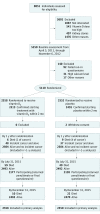Monthly High-Dose Vitamin D Supplementation and Cancer Risk: A Post Hoc Analysis of the Vitamin D Assessment Randomized Clinical Trial
- PMID: 30027269
- PMCID: PMC6248079
- DOI: 10.1001/jamaoncol.2018.2178
Monthly High-Dose Vitamin D Supplementation and Cancer Risk: A Post Hoc Analysis of the Vitamin D Assessment Randomized Clinical Trial
Abstract
Importance: Previous randomized clinical trials have reported inconsistent results on the effect of vitamin D supplementation on cancer incidence.
Objective: To examine whether high-dose vitamin D supplementation received monthly, without calcium, is associated with a reduction in cancer incidence and cancer mortality in the general population.
Design, setting, and participants: This is a post hoc analysis of data from the Vitamin D Assessment (ViDA) study, a randomized, double-blind, placebo-controlled trial that recruited participants from family practices and community groups in Auckland, New Zealand, from April 5, 2011, through November 6, 2012, with follow-up completed December 31, 2015. Participants were adult community residents aged 50 to 84 years. Of 47 905 adults invited from family practices and 163 from community groups, 5110 participants were randomized to receive vitamin D3 (n = 2558) or placebo (n = 2552). Two participants withdrew consent, and all others (n = 5108) were included in the primary analysis. Data analysis was by intention to treat.
Interventions: Oral vitamin D3, in an initial bolus dose of 200 000 IU and followed by monthly doses of 100 000 IU, or placebo for a median of 3.3 years (range, 2.5-4.2 years).
Main outcomes and measures: Post hoc primary outcome was the number of all primary invasive and in situ malignant neoplasms (excluding nonmelanoma skin cancers) diagnosed from randomization until the study medication was discontinued on July 31, 2015.
Results: Of the 5108 participants included in the analysis, the mean (SD) age was 65.9 (8.3) years, 58.1% were male, and 4253 (83.3%) were of European or another race/ethnicity, with the remainder being Polynesian or South Asian. Mean (SD) baseline deseasonalized 25-hydroxyvitamin D concentration was 26.5 (9.0) ng/mL. In a random sample of 438 participants, the mean follow-up 25-hydroxyvitamin D concentration consistently was greater than 20 ng/mL higher in the vitamin D group than in the placebo group. The primary outcome of cancer comprised 328 total cases of cancer (259 invasive and 69 in situ malignant neoplasms) and occurred in 165 of 2558 participants (6.5%) in the vitamin D group and 163 of 2550 (6.4%) in the placebo group, yielding an adjusted hazard ratio of 1.01 (95% CI, 0.81-1.25; P = .95).
Conclusions and relevance: High-dose vitamin D supplementation prescribed monthly for up to 4 years without calcium may not prevent cancer. This study suggests that daily or weekly dosing for a longer period may require further study.
Trial registration: anzctr.org.au Identifier: ACTRN12611000402943.
Conflict of interest statement
Figures
Comment in
-
Role of Monthly High-Dose Vitamin D Supplementation in Cancer Prevention-In Reply.JAMA Oncol. 2019 Apr 1;5(4):572-573. doi: 10.1001/jamaoncol.2018.7233. JAMA Oncol. 2019. PMID: 30763440 No abstract available.
-
Role of Monthly High-Dose Vitamin D Supplementation in Cancer Prevention.JAMA Oncol. 2019 Apr 1;5(4):572. doi: 10.1001/jamaoncol.2018.7214. JAMA Oncol. 2019. PMID: 30763442 No abstract available.
References
-
- Schwartz GG, Hulka BS. Is vitamin D deficiency a risk factor for prostate cancer? (Hypothesis). Anticancer Res. 1990;10(5A):1307-1311. - PubMed
Publication types
MeSH terms
Substances
Associated data
Grants and funding
LinkOut - more resources
Full Text Sources
Other Literature Sources
Medical
Miscellaneous



